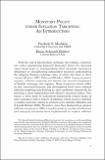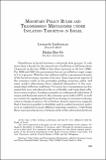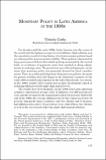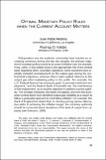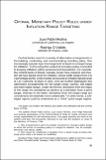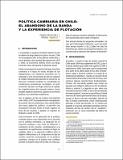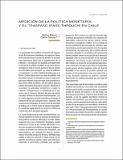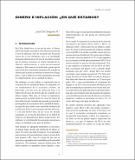Search
Now showing items 71-79 of 79
Monetary policy under inflation targeting: an introduction
With the end of intermediate exchange rate regimes, countries are either abandoning domestic monetary policy (by choosing super-hard pegs or relinquishing their national currencies altogether) or strengthening independent monetary policymaking (by adopting floating exchange rates, of either the clean ...
Monetary policy rules and transmission mechanisms under inflation targeting in Israel
Disinflation in Israel has been a relatively slow process. It took more than a decade for the annual rate of inflation to fall from about 18 percent in the late 1980s to less than 4 percent in the late 1990s. For 2000 and 2001 the government has set an inflation target range of 3 to percent. Whether ...
Monetary policy in Latin America in the 1990s
For decades until the early 1990s, Latin America was the region of the world with the highest average level of inflation. High inflation was the cumulative result of a long history of activist economic policies based on a disregard for macroeconomic stability. These policies culminated in large ...
Optimal monetary policy rules when the current account matters
Policymarkers and the academic community have reached an increasing consensus during the last two decades: the primary objective of monetary policy should be to control inflation (see, for example, King, 1999). A less settled issue is the appropriate role of the central bank regarding other, secondary ...
Optimal monetary policy rules under inflation range targeting
Central banks resort to a variety of alternative arrangements in formulating, conducting, and communicating monetary policy. One increasingly popular type of arrangement is based on a target range for inflation. In this setup the conduct of monetary policy is oriented to keeping inflation withing ...
Policy rules and external shocks
The decade since 1990 has been a period of innovation in monetary policy. Around the world, many countries have adopted inflation targeting as their basic policy framework. Different countries have tried different techniques for achieving inflatio targets, such as different choices of policy instruments.
Política cambiaria en Chile: el abandono de la banda y la experiencia de flotación
Como muchos otros países, en los últimos cuarenta años Chile ha experimentado virtualmente todos los sistemas cambiarios posibles, con la excepción de adoptar una moneda foránea. La búsqueda de una política cambiaria adecuada ha estado determinada, en parte, por los distintos objetivos que han tenido ...
Medición de la política monetaria y el traspaso (pass-through) en Chile
Primero, este trabajo presenta una revisión de los principales estudios con VAR monetarios en Chile y en el mundo para medir la política monetaria y el traspaso del tipo de cambio a precios (pass-through). Segundo, se estiman tres VAR estructurales con restricciones de corto plazo y un VEC con ...
Dinero e inflación ¿en qué estamos?
Este trabajo analiza el rápido crecimiento del dinero (M1A) en la economía Chilena, el cual se ha dado en conjunto con una baja tasa de inflación y en el contexto de una relajación de la política monetaria. Esto ha sido usado como fundamento para argumentar que este crecimiento del dinero es incompatible ...

